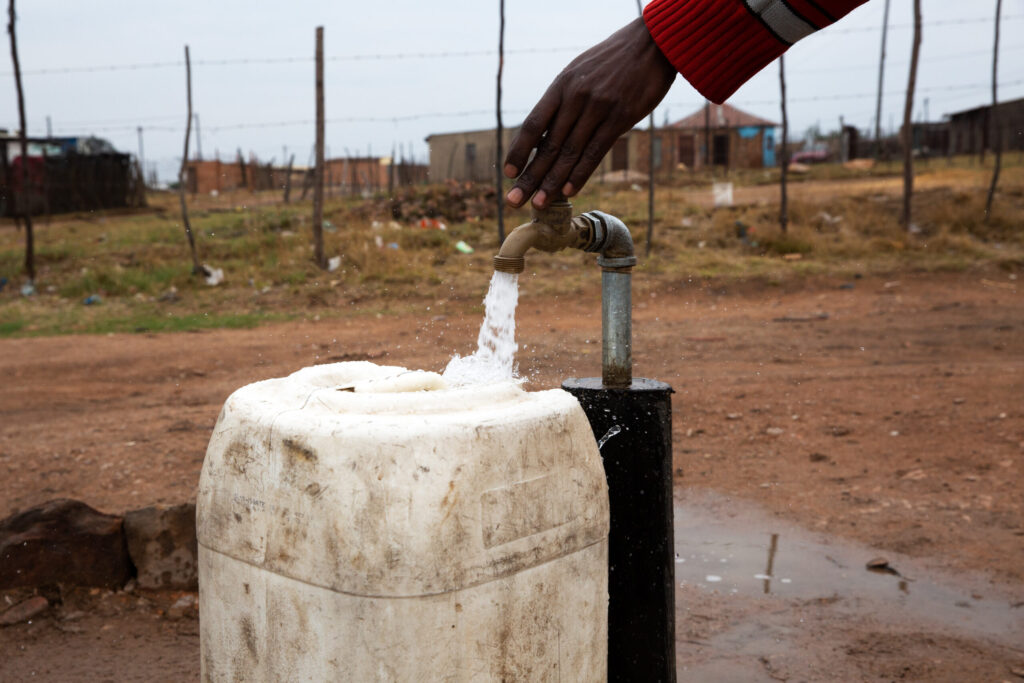- When sewage gets into drinking water, germs that cause bad diarrhoea and dehydration, such as E. coli and cholera bacteria, spread quickly.
- With disruptions brought on by extreme weather events like droughts and floods becoming more frequent as weather patterns change, disease-causing organisms that live in water will likely spread too.
- In this month’s episode of Health Beat, Mia Malan spoke to Tom Boyles, an infectious diseases expert, about what the future will look like when people don’t have clean, safe water.
Facing a cyclone is bad. Facing the fallout afterwards is worse — especially in places where sanitation systems are shaky to start with.
With extreme weather events likely to become more frequent because of climate change, so too could disease outbreaks that spread through water, like cholera.
Malawi is already in the wake of the storm. The country usually sees seasonal outbreaks of cholera during the rainy summer season, but last year, after two cyclone-like storms in short succession, the disease spread far beyond the areas affected by floods — and long into the dry season. In its biggest outbreak so far, the country reported close to 59 000 cases and more than 1 700 deaths since March last year.

But while something like cholera usually hits hard and fast after a weather disaster, a disease such as bilharzia simmers like a hot pot. The worm that causes the illness hitches a ride on a specific type of freshwater snail, and as places become warmer, conditions make it easier for the snails to gradually creep into rivers in areas where they never used to be — bringing the worms along.
In the latest episode of Health Beat, Bhekisisa’s monthly TV show, Mia Malan spoke to Tom Boyles, an infectious diseases expert at Right to Care, about how dirty water and the lack of proper sanitation violate people’s right to healthy lives.
[WATCH] The full interview with Tom Boyles
Mia Malan (MM): What are the links between infectious diseases and dirty water?
Tom Boyles (TB): Pathogens [disease-causing organisms] can spread through water. We often start with the small ones, which are viruses, like hepatitis A and hepatitis E. Then there are bacteria [such as] E. coli [and those that cause] typhoid or cholera, which was recently in the news. Then [there are] slightly larger organisms that can cause infections like amoebic dysentery [which cause stomach cramps and diarrhoea]. These organisms are mostly found in the gut of either humans or animals, and come out in stool. If that stool contaminates water that somebody drinks, then they risk being infected, which can cause disease.
MM: In a place like Hammanskraal, where the municipality provides drinking water in trucks, how likely is it that the source of cholera could have been that water, if it wasn’t cleaned properly?
TB: In Hammanskraal, where there was a large outbreak, it seems likely that people were drinking from the same contaminated source of water. I don’t know if there’s evidence to prove that [that water was the source], but it would be the first place to look. For cholera to spread from person to person the stool of one person has to get into the mouth of another. It doesn’t have to go through the water cycle — it can [also spread] if you’re caring for somebody with cholera who’s got serious diarrhoea. But I don’t think that would be enough to explain this large outbreak.
[WATCH] How should the government clean your tap water?
MM: What will the future look like with diseases that spread through water, if we continue to deprive so many communities of clean running water?
TB: It’s bleak. We see it happening in other countries. [For example], there was a large cholera outbreak in Malawi [that started in March last year]. [The country] has poor water infrastructure and hundreds of people died. Once the bacteria are in circulation, there’ll be people with mild symptoms, passing it through stool. If that water isn’t cleaned before it’s drunk, then that’s where you get an outbreak. We’re focusing on cholera, but this [also holds] for a range of illnesses and organisms. If our water system deteriorates further, and more people have no access to clean drinking water, then we’re going to see more of this.
[WATCH] How to diagnose & treat cholera: A guide for health workers
MM: Access to clean water is a human right. But are people aware of this, and is anyone listening?
TB: Not in my experience. I’ve lived in rural areas that have one or two taps for a village — that’s it. The taps are often dry or they don’t work, and so people collect water from a river or store rainwater. Rainwater is great if people can afford [storage] tanks, but they also run dry. Where there are few toilets, then the link is obvious: if people are emptying their bowels near a river, the germs are going to get into that water. And if you drink that water without cleaning it, then you’re going to get a disease. In my experience of working in [the Eastern Cape] 10 to 15 years ago, it’s often children who suffered the most. They came into hospitals with severe diarrhoea and dehydration. It took me a long time to work out why there were [such] peaks, but it turned out that [cases would rise] just after the rain tanks ran dry [and] people went to the river. Children [would] drink dirty water, and we’d see an outbreak every year. Educating people about this is important, because if you’re able to boil that water for two minutes, and cool it down before drinking it, then the germs will be killed. People need to be aware of that. But also, they’d need the fuel and the time to boil water and cool it down before they drink it.
[WATCH] Why this community is fed up with pollution in the Vaal River
MM: We also get diseases that are not transmitted through drinking, but through other contact with organisms in water, such as freshwater snails. What do higher temperatures mean for outbreaks of such diseases?
TB: What the impact of climate change is going to be is a big topic in the field of infectious diseases. And it’s climate disruption as much as anything else. Think about schistosomiasis, also known as bilharzia. It is an infection that you get from bathing or swimming in water [that parasitic worms live in], not from drinking it. It’s common in a belt from the Eastern Cape all the way up the coast into Mpumalanga and Limpopo. The cycle of illness needs humans, [freshwater] snails [which host the worms] and [the] parasites. In the Western Cape, there are none of these [host] snails, because the climate isn’t right. So there’s no bilharzia. But as temperatures rise, the range where the snails can live will likely shift. The same will happen with malaria: as things get warmer, the range of malaria-carrying mosquitoes shifts. But climate disruption is a bigger issue for waterborne diseases because of extreme weather events. For example, [in] Malawi we saw cyclones likely linked to climate change and then a cholera outbreak. [Those kinds of storms] disrupt [clean] water supply, and you get bigger runoff. Any pathogens that are in soil will more likely make it into a water source. The impact of climate change on waterborne diseases is going to be large, and I suspect it will mostly be [felt] through disruption from extreme weather events.









